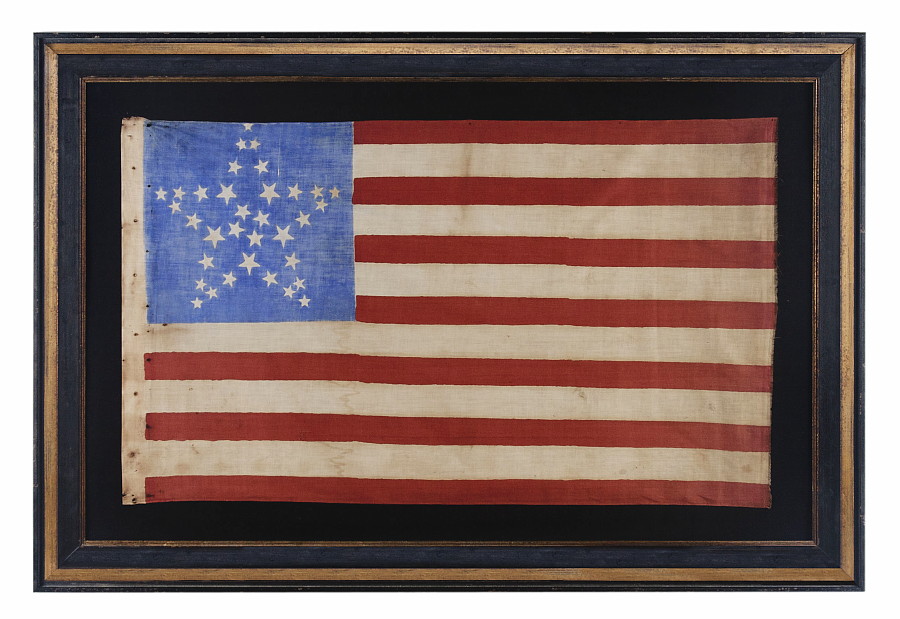
| |
34 STARS IN 4 DIFFERENT SIZES, ARRANGED IN THE "GREAT STAR" OR "GREAT LUMINARY" PATTERN ON A CORNFLOWER BLUE CANTON, CIVIL WAR PERIOD, 1861-63, KANSAS STATEHOOD |
|
| Available: |
Sold |
| Frame Size (H x L): |
35.75" x 52.75" |
| Flag Size (H x L): |
24.5" x 42" |
|
| Description....: |
|
34 STARS IN 4 DIFFERENT SIZES, ARRANGED IN THE "GREAT STAR" OR "GREAT LUMINARY" PATTERN ON A CORNFLOWER BLUE CANTON, CIVIL WAR PERIOD, 1861-63, KANSAS STATEHOOD:
34 star American national parade flag of the Civil War period, printed on cotton. The stars are arranged in a rare and beautiful variation of what is known as the "Great Star"--a large star made out of smaller stars--which ranks firmly among collectors as one of the most coveted of all 19th century geometric designs.
Even among those with Great Star patterns, this is a beautiful flag, both because of the 4 different sizes of stars used in the configuration and the brilliant cornflower blue color of the square canton. Note how the arms of the star are open. Because only 4 stars are used on the Great Star’s interior, arranged in a tight cluster in the center, I have sometimes referred to this particular arrangement as a "Great Flower", noting the center stigma and 5 surrounding petals.
Because there was no official way to arrange the stars on the American national flag until 1912, the configuration was left up to the flag-maker. The same was true of the number of points on the stars, their size, the proportions of the flag itself, its canton and choice of colors within the spectrum of red and blue. The Great Star probably came about shortly after the War of 1812, when Congressman Peter Wendover, of New York, requested that Captain Samuel Reid, a War of 1812 naval hero, sought to create a new design that would become the third official format of the Stars & Stripes. A recipient of the Congressional Medal of Honor, Reid became harbor master of New York following the war. During his lifetime, he created many innovations in signal use, including a system that could actually send messages from New York to New Orleans by sea in just two hours.
Use as a Naval signal had been the primary reason for the initial creation of an American national flag in 1777, but since there was no official star design, the appearance of our flag varied greatly. Reid’s primary concern centered on both consistency and ease of recognition. His hope was as more and more states joined the Union and more and more stars were added to the flag, that it would remain easily identified on the open seas. In 1818, Reid suggested to Congress that the number of stripes permanently return to 13 (reduced from 15) and that the stars be grouped into the shape of one large star.
Reid’s proposal would have kept the star constellation in roughly the same format, in a pattern that could be quickly identified through a spyglass as the number of states grew. His concept for the stripes was ultimately accepted, but his advice on the star pattern was rejected by President James Monroe, due to the increased cost of arranging the stars in what would become known as the “Great Star”, “Great Flower”, or “Great Luminary” pattern. Monroe probably didn’t wish to impose this cost on either the government or civilians, so he suggested a simple pattern of justified rows. Never-the-less, the Great Star was produced by anyone willing to make it and its rarity today, along with its beauty, has driven the desirability of American flags with this configuration.
Kansas was admitted into the Union as the 34th state on January 29th, 1861, about 2 ½ months before the Confederate assault on Fort Sumter that marked the beginning of the Civil War. The 34th star was officially added on July 4th of that year, but most flag makers would have added a 34th star with the addition of Kansas in January. The star count remained official until July 4th, 1863, and 34 star flags would have been produced until the addition of West Virginia in June of that year.
Mounting: The flag has been hand-stitched to 100% cotton, black in color, which was washed to remove excess dye. An acid-free agent was added to the wash to further set the dye and the fabric was heat-treated for the same purpose. The mount was then placed in a black-painted, hand-gilded and distressed Italian molding. The glazing is U.V. protective acrylic.
Condition: There are a number of tack holes with rust stains along the hoist end, where the flag was affixed to a wooden staff. There is minor foxing and staining elsewhere in the body of the flag. There is some dye loss in the blue canton and very minor fading of the red stripes at the fly end. This is a very rare example that well-warrants any condition issues. Many of my clients enjoy flags that attractively show their age and obvious use. |
|
|
|
| Collector Level: |
Flags for the truest Patriots. My best offerings |
|
| Flag Type: |
Parade flag |
|
| Star Count: |
34 |
|
| Earliest Date of Origin: |
1861 |
|
| Latest Date of Origin: |
1863 |
|
| State/Affiliation: |
Kansas |
|
| War Association: |
1861-1865 Civil War |
|
| Price: |
SOLD |
|
| |
Views: 4004 |
|
|
|

